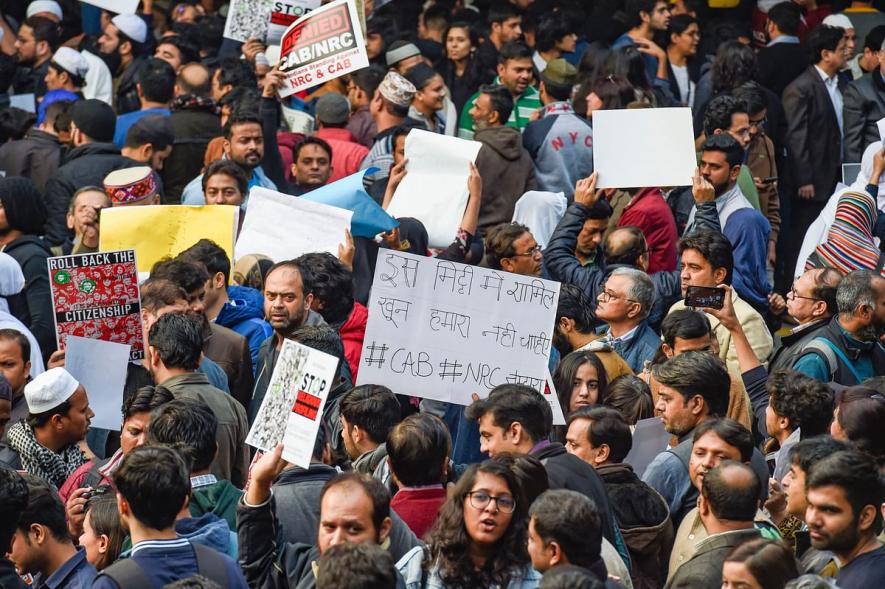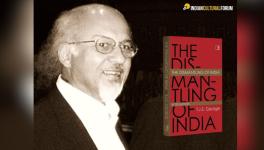CAA-NRC: Turning India Into a Warzone of ‘Peace’

Image Courtesy: Free Press Journal
The Bharatiya Janata Party-led central government has pushed the Citizenship Amendment Act through, but it is struggling to manage its fallout and the national outrage that a related proposal to create a National Register of Indian Citizens or NRIC has generated. At first, BJP leaders desperately assured those who were excluded in the NRC, or national register of citizens, that was finalised in October this year for the people of Assam. Its pleas were meant to reassure the Hindus who were excluded in the state’s citizen-count that it would hold a fresh all-India count of citizens, in which they will be included. The reason for the BJP’s desperation was the outcome of the Assam NRC, which turned out to be contrary to its expectations: out of 19 lakh found “illegal” in the state, only about 5 lakh are Muslim, almost all the rest are Hindu.
Yet, the fears of the citizenship law, combined with the resistance to an all-India NRC, have now given rise to tremendous mass resistance across India. There have been massive marches and rallies in many places, some of them culminating in aggressive confrontations with police and security forces. There is an ongoing massive crackdown on several universities, including in Lucknow, Aligarh, and Delhi where students were agitating against the new citizenship law and the all-India listing of citizens or NRIC.
Several Opposition-ruled states, Kerala and West Bengal included, have already declared that they will not implement the new citizenship law or NRIC. The most militant resistance to the new citizenship law, however, has come forth in the North-east. The situation there is so severe that a significant part of the region stands cut off from the mainland with trains cancelled. There is a Kashmir-like Internet ban in many parts of the North-east.
The resistance to the Citizenship Amendment Act (CAA) and NRIC are in fact a manifestation of India’s vast diversity and plurality. Both the government’s plans—to count citizens and segregate them from non-citizens and to redefine Indian citizenship along religious lines—hold different meanings in different parts of the country. While in the North-east, the CAA is being construed as an attack on language, identity and culture, in the South, the once-powerful Dravida sentiment against Delhi have shown stirrings of revival.
Whether the RSS-BJP expected this scale of resistance from people is unknown, but perhaps they calculated that it would bolster their heartland vote bank. In fact, it is being reported that they have planned a nationwide campaign in support of the Citizenship Act.
The arbitrariness of the bill lies not just in its exclusions: for instance, it has kept out Tamil refugees (a majority of whom are Hindu), by excluding Sri Lanka entirely. The law has limited India into accepting non-Muslim refugees from only three Muslim-majority neighbours, Pakistan, Afghanistan and Bangladesh. India shares a border with Bhutan, Myanmar and Nepal, and it is widely known that sections of minorities are persecuted in these countries too. For example, Ahmediyas and Hazaras in Pakistan, Bihari Muslims in Bangladesh and Rohingyas in Myanmar, whom the United Nations has termed the “most persecuted community in the world”.
In practice, the combined effect of the NRC and CAA will be to declare Muslims residents of India as non-citizens, and non-Muslim immigrants as citizens. For this reason and more, the international human rights organisation, Amnesty International, has said that this amendment to the Citizenship Act of 1955 is a “bigoted law that must be immediately repealed”.
It is being said that under the garb of humanitarianism the CAA has basically upturned the Constitution by slyly trying to introduce religious right-to-return. Remember, unlike Israel and Korea (both South and North) and a few other countries, Indian laws or the Constitution do not recognise any “right to return”. Yet, the law-makers did not just advocate the right to return with this bill, but with their brute majority in Parliament, hurriedly passed it into law.
The United Nations has called CAB “fundamentally discriminatory”, and deleterious to equality before the law. On the one hand, India has signed off on the International Covenant on Civil and Political Rights and the Convention for the Elimination of Racial Discrimination, and on the other hand it is promoting discrimination based on ethnic and religious grounds, which these covenants strictly prohibit. Merely a year ago, India endorsed the Global Compact for Safe, Regular and Orderly Migration, which commits nation-states to respond to the needs of migrants in situations of vulnerability, avoid their arbitrary detention and collective expulsion and ensure that all migration governance measures are human rights-based.
Besides, the Indian government never collected or declared facts and figures to show how many persecuted people have sought asylum in India from Pakistan, Bangladesh or Afghanistan. Also, the Modi-Shah government has also refused to acknowledge that its enactment would have a very negative impact on the non-Muslim minorities—the very people it claims to be protecting—who live in these neighbouring Muslim-majority countries.
The question arises, why did the Modi-Shah duo limit the bill to three neighbouring Muslim-majority countries? Remember, Aung San Suu Kyi, once a respected global human rights activist and leader of Myanmar resistance, now faces International Court of Justice at the Hague hearings over allegations of genocide for how her regime has treated the Rohingya minority. The government’s concern, perhaps, is to establish greater rapport with Myanmar and Sri Lanka and thus not ruffling their feathers.
Myanmar and Sri Lanka’s Exclusion from CAA
The foremost reason for these exclusions is the BJP and RSS wish to project “a macro-historical conviction on behalf of [the] Hindutva rightwing that India is in essence a Hindu country and deserves to be a Hindu rashtra.” Remember, Hindutva rightwing maintains that an ‘Akhand’ or ‘undivided’ Bharat once included Afghanistan, Pakistan and Bangladesh. Hindutvadis also hold the view that Indian Hindus are specially obliged to “accommodate religiously-persecuted Hindus (and other non-Muslim minority groups) as Indian citizens.”
Recall Prime Minister Narendra Modi’s visits to Myanmar, which led to a joint statement last year that was silent on the mass-ethnic cleansing of the Rohingyas, but expressed concerns on the “terrorist” activities of a section of Rohingyas. It read, “It is important to maintain security and stability along the long land and maritime borders of India and Myanmar... India stands with Myanmar over the issue of violence in the Rakhine state which has led to loss of innocent lives.”
Or how it went the extra mile to establish better relations with the new dispensation in Sri Lanka led by Gotabaya Rajapaksa and his brother Mahinda Rajapaksa and it did not matter to it that elected President has been under scanner for his alleged role in human rights violations while dealing with Tamil militancy.
It is also a reported that a section of Hindutva leaders has written comments sympathetic to Buddhist extremism in both countries. The extremist, Ashin Wirathu’s 969 Group in Myanmar and Bodu Bala Sena or Buddhist Power Force in Sri Lanka, are said to be involved in anti-Muslim violence - and these formations themselves have reported how they are in touch with their counterparts in India who are working on a Hindutva supremacist agenda to form a “Hindu-Buddhist peace zone” in South Asia against the “common enemy”, Muslims.
Status of Sri Lankan Refugees in India
Interestingly, while the draft bill mentioned giving citizenship to victims of “religious persecution”, the final bill passed by Parliament does not mention or even define persecution and instead uses the word “any” persons, while limiting the countries from which people can seek citizenship to three.
Dharshini, 34, is a Sri Lankan Tamil refugee, one of over 65,000 who live in various camps, mostly in the southern state of Tamil Nadu. She and her family fled to India in 1990 by boat and have settled down at a camp for other Sri Lankan Tamils at Gummidipundi. After 25 years of living in great penury in India, they had hoped the CAA would accommodate them as citizens, but this was not to be. Now these refugees will continue to live under the fear of deportation.
The question is, why has a bill that made “inclusive” noises—including in the statement of objects and reasons in its final version cleared by Parliament—denied Tamil immigrants fleeing persecution in Sri Lanka the change to seek permanent citizenship.
In all of India, this Act is being clearly seen for what it is: an attempt to make Muslims secondary citizens and to throttle the Constitution and drive India closer to dystopia.
Welcome to Hindu rashtra via citizenship.
The author is an independent journalist. The views are personal.
Get the latest reports & analysis with people's perspective on Protests, movements & deep analytical videos, discussions of the current affairs in your Telegram app. Subscribe to NewsClick's Telegram channel & get Real-Time updates on stories, as they get published on our website.
























